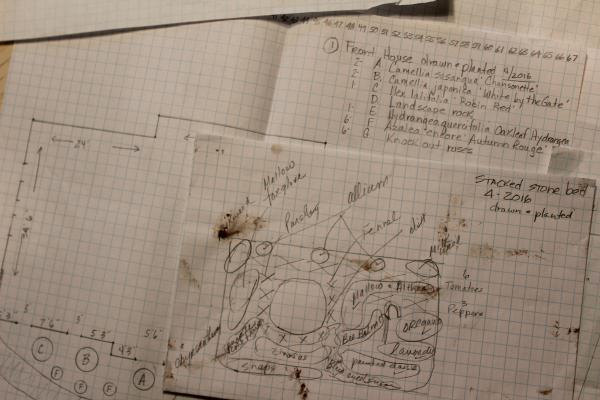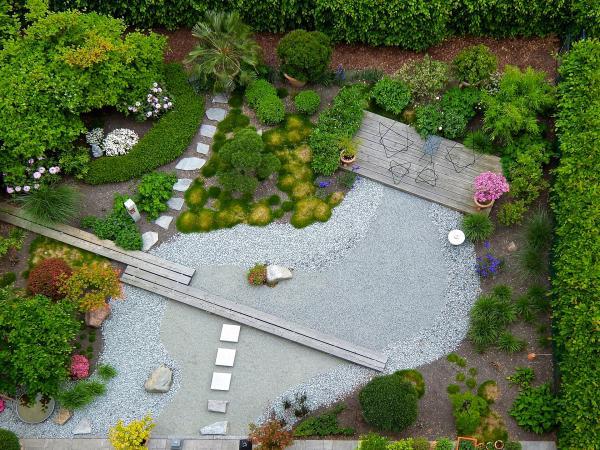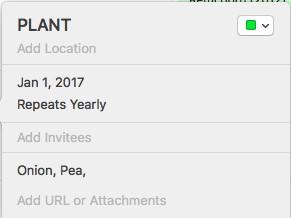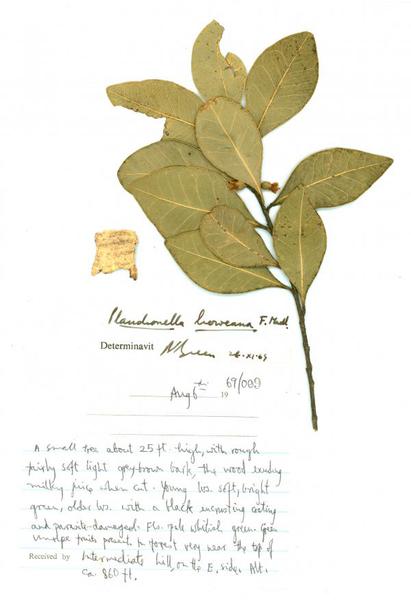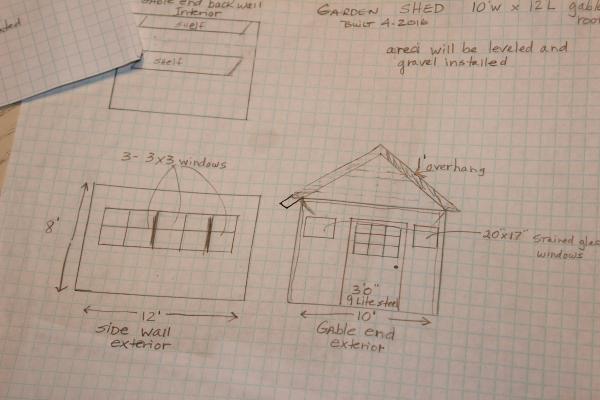Garden Journals–A Powerful Tool for Success
Gardening provides exercise, stress relief, enjoyment, beauty and a satisfaction that continues to grow as plants do. To maximize the benefits, keep a garden journal and record information and observations about plants, weather events, soil conditions, and wildlife encounters. A well-used garden journal is a powerful resource for any gardener.
Garden journals are as varied as the perennials in a garden. They may be a simple hardbound (Figure A–1) or spiral notebook (Figure A–2), recorded on graph paper notebook (Figure A–3), collected in a three-ring binder, or come in scrapbook form. If traditional paper formats do not appeal to you, consider recording data and observations in one of the countless digital formats (Figure A–4, Figure A–5) available online for free or purchase. Selecting a style is a matter of preference, choose a format you are comfortable with and committed to using on a regular basis. By recording information over a long period of time, you will create an invaluable source of information about your yard and garden that will guide you in making any future decisions about plants, problems, or design.
Capturing information about the site, seasonal factors, plants, pests, projects, and expenses will provide the data necessary to make informed decisions and have a successful thriving garden now and in the future.
1. Site Characteristics
Understanding site characteristics is critical to selecting plants that will thrive in a specific location. Take time to observe patterns of sun and shade. Identify the time of day the site is in shade and the level of shade (dappled, dense). Notice the direction slopes and swales face. How does wind affect the site? Every location has its own unique microclimate. Making the most of a location's strengths and avoiding known problems will lead to a more successful gardening experience. Recording details about different locations in the garden will serve as a guide for plant replacements, future projects, or expansions.
- Creating a drawing to scale using graph paper (Figure A–6) or a computer software program (Figure A–7) is especially helpful when designing a garden space. Be sure to include the location of all buildings, utilities, hardscapes, and plants. Make the drawing large and detailed enough to recognize plants later. Drawing in pencil allows you to make adjustments if you lose a plant or transplant something.
- Make note of the wet and dry areas of your yard.
- Follow the sun throughout the season noting areas of shade throughout the day. Remember that over time some sunny locations may transition into partial sun or even full shade so be sure to update your maps on a regular basis.
- Documenting all of the plants and hardscape elements in a location helps you to analyze their interactions—are your Carolina rhododendrons (Rhododendron minus) struggling under the shade of a pin oak (Quercus palustris) tree? Are the roots of your obedient plant (Physostegia virginiana) choking out your tulip (Tulipa spp.) bulbs? Is that western wall reflecting heat and burning the leaves of your American beautyberry (Callicarpa americana) shrub?
- Plants can outgrow their locations. Recording their appearance helps you understand why a plant that once thrived might be suffering now.
Soils
- Conduct a soil test when you first begin to garden and every few years thereafter. This information will help you identify plants that will thrive in your specific setting as well as provide recommendations for fertilizers and soil amendments. Keep track of all soil test results in your garden journal. Preparing a table will allow you track changes over time and color-coding the cells makes it easy to decipher. (Table A–1). Note the dramatic increase in copper and zinc in where a huge load of uncertified compost was applied. Remember to document any soil amendments including brand names, nutrient amounts, amount applied, garden location, and dates.
2. Seasonality
Many events like plants blooming, pollinators visiting, or leaves turning color, happen in a cycle in the garden. While we have the best intentions of recalling the details, without writing down the dates and our own reflections, much of this information is lost. By capturing the month, day, year, and time in each journal entry we can create a body of information that allows us to reflect and learn from our triumphs and mistakes.
Information to Collect
Weather: Collect environmental data like rainfall, temperature, humidity, day length, cloud cover, frost events, and storm damage. This data allows you to see the effect of the environment on your plants and guide you in plant and pest management decisions.
Keeping track of weather and weather patterns in your area will help you become a more knowledgeable gardener.
By capturing weather data you can identify if your microclimate typically sees a later than average last frost or gets higher than average temperatures in the summer. This type of data can help you decide when to plant your tender annuals or find a plant that can withstand your high summer temperatures. Table A–2 is an example of gathering weather data like maximum, minimum, and mean temperatures, precipitation, cooling, and heating hours, along with historical climate data.
Chores: Develop a calendar either on paper (Figure A–8) or digitally (Figure A–9) with a seasonal chore lists of typical garden work like planting, fertilizing, pruning, deadheading, seed collection, weeding, mulching and pest management. Creating a seasonal chore list spreads garden work throughout the year and allows for planning of future tasks. Winter may be a quiet time in the garden but it is the perfect season for planning and researching the next garden project. Spring is a very busy time in the garden so moving the construction of a tool shed to the fall might be a better use of your growing season. If you find useful information or a new technique in a book, on a website, or from a fellow gardener, make a reminder in your journal to try this new technique when the season permits.
Seasonal Plant Characteristics: Having color and interest every season provides enjoyment year-round. A simple list of the months and which plants are blooming will show you where you may have holes in your landscape. If drawing on graph paper, consider using transparent sheets over your main map to indicate how the plants and landscape change through each of the four seasons. Notice plant features including attractiveness to wildlife, edibility, fragrance, and leaf and bark color. Recording the location of plants that go seasonally dormant allows you to recognize bare areas and plan for year-round interest.
3. Plants
Getting to know the plants in your yard or garden and their individual requirements will help you identify where they will thrive and allow you to follow the popular gardening mantra “the right plant in the right place.” Plants arrive in your garden from a variety of locations, whether they are volunteers that germinate unexpectedly from the soil, divisions from a generous neighbor, seeds shared by a friend, or pots purchased from a local nursery. Some plants may have plant tags with a great deal of information like Latin and common names, sun preferences, bloom times, and watering requirements, while mystery plants, with no tags, must grow large enough to produce identifying features such as mature leaves or flowers before you can look up their descriptions. Keeping records of where plants are obtained, the cost, any information from the label, or gathered from books or the internet, is an important part of any garden journal.
Plant Profiles
Creating plant profiles for an individual plant or family of plants will assist you in becoming more familiar with the plants in your yard. Plant profiles include:
- Latin and common names as well as plant family to help with crop rotation or in the case of pests or diseases. You may want to include a pronunciation guide.
- Information about where the plant was purchased or found and its cost.
- The date it was planted.
- Its expected mature height and width.
- Your observations about the plant, its foliage, flowers, fragrance, color.
- Any known or observed problems.
- Activities around the plant such as pruning, fertilizing, or pest management, and the date completed.
Images
Continually capture various images of your garden from many angles and throughout the seasons. Images can be photographs or illustrations if you are artistic. These images will not only assist in identifying plants but also gives you a reference for observing how plants change through the seasons and the years. Remember to take "before" photos of the landscape as well as "in progress" photos. Capture both macro photos of plant details as well as large scale landscape photos. Taking photos of plant labels and seed packets is another way to record data without manually entering it into your journal.
Creating pressed plant specimens (Figure A–10) as part of your plant profile is an alternative to photographs or drawings and helps you become more familiar with your plants. Pressed, dried plants allow you to study their leaf, stem, and flower structures and give you a reference point even when the plants are dormant.
Harvests
Keeping track of fruit, vegetable, or nut harvests will help you plan for future crops.
Collecting and storing seeds is a fun hobby that helps make gardening more economical. Keeping track of which seeds are stored, dates of storage, and information about germination rates helps you get the most out of your seed bank.
4. Pests
While good management practices minimize the presence of pests and pathogens in a garden, every gardener inevitably encounters them. "Scouting," or regularly examining plants including the bark, under the leaves, and around the soil helps with early identification of problems. Creating detailed records assists with the proper identification of the pest and proper management strategies. Read more in chapter 8, "IPM."
1. Plant: Record the plant description, symptoms, and signs.
2. Environment: Capture the location, season, and weather when the problem occurred.
3. Pest: Accurately identify the insect, disease or animal that is causing a problem.
4. Action Taken: Describe cultural, mechanical, biological, and chemical management strategies.
5. Results: Document any outcomes.
5. Projects
Having an area of your journal dedicated to special garden projects will not only help you keep to your budget and deadlines but will help you avoid repeating mistakes. Capture information including start and stop dates, supply lists, contact phone numbers and sources, any obstacles encountered, and notes about how they were overcome. Leave room to make detailed drawings of any building projects (Figure A–11) so you can take your journal with you when you pick up materials.
6. Expenses
Budgeting and keeping track of expenses is an important part of any garden project. Tracking the date purchased, quantity, source, item information, and evaluation of the product will help you evaluate successes and failures and assist in making better purchases over time. Photographing products and price labels is a quick and easy way to capture a lot of information that saves you time when it comes to entering budget information.
7. Tips
- Creating a space in your journal for simple observations is a great way to form connections and help you identify patterns in your garden. "I saw" pages help you record creatures, plants, people, relationships, connections, symptoms, and signs.
- Leave room for jotting down questions or tips learned from other gardeners.
- No matter how much we pamper our plants, there will always be casualties. Record the plant name, the circumstances under which it died, and any recommendations for next time.
- Consider including some fun elements in your journal, like envelopes for collecting specimens, gluing in old seed packets or product labels, and pasting in photos or illustrations from magazines or books.
- Using clear page protectors prevents wear and tear, and adding tabs to your journal helps you quickly locate the section you are looking for.
- Drawing conclusions from observations and data collection is an important part of your garden journal. Making notes about what worked or did not work guides future decisions.
Summary
No matter what format your garden journal takes—from a three-ring binder to an app on your phone or tablet—the simple process of observing and recording will provide you with invaluable information to guide you in creating the garden of your dreams.
If you have questions about this appendix contact your local N.C. Cooperative Extension center.
Contributors
Authors: Lucy Bradley, Associate Professor and Extension Specialist, Urban Horticulture, NC State University; Director, NC State Extension Master Gardener program
Kathleen Moore, Urban Horticulturist
Contributions by Extension Master Gardener Volunteers: Lise Jenkins, Sandy Ritter, Chris Alberti, L. Amy Rozycki, Jackie Weedon, Karen Damari, Jayne Boyer
Content Edits: Lucy Bradley, Associate Professor and Extension Specialist, Urban Horticulture, NC State University; Director, NC State Extension Master Gardener program
Kathleen Moore, Urban Horticulturist
Graphic Design: Premila Jayaratne
Copy Editor: Barbara Scott
Publication date: Feb. 1, 2022
AG-831
Other Publications in North Carolina Extension Gardener Handbook
- 1. Soils & Plant Nutrients
- 2. Composting
- 3. Botany
- 4. Insects
- 5. Diseases and Disorders
- 6. Weeds
- 7. Diagnostics
- 8. Integrated Pest Management (IPM)
- 9. Lawns
- 10. Herbaceous Ornamentals
- 11. Woody Ornamentals
- 12. Native Plants
- 13. Propagation
- 14. Small Fruits
- 15. Tree Fruit and Nuts
- 16. Vegetable Gardening
- 17. Organic Gardening
- 18. Plants Grown in Containers
- 19. Landscape Design
- 20. Wildlife
- 21. Youth, Community, and Therapeutic Gardening
- Appendix A. Garden Journaling
- Appendix B. Pesticides and Pesticide Safety
- Appendix C. Diagnostic Tables
- Appendix D. Garden Tools
- Appendix E. Season Extenders and Greenhouses
- Appendix F. History of Landscape Design
- Appendix G. Permaculture Design
- Appendix H. Community Gardening Resources
- Appendix I. More NC State Resources
- Glossary
N.C. Cooperative Extension prohibits discrimination and harassment regardless of age, color, disability, family and marital status, gender identity, national origin, political beliefs, race, religion, sex (including pregnancy), sexual orientation and veteran status.


.jpg)



